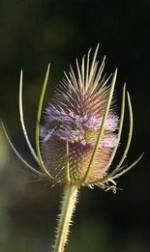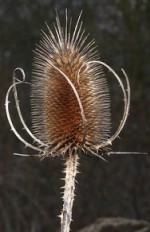 Brought to North America from Europe in the early 1700’s to raise the nap of wool cloth, fuller’s teasel naturalized and is now considered a weed in many parts of the United States. It is an unpleasant plant to be near because of its treacherous spines but butterflies and bees love the flowers, birds especially goldfinches love the seed, and the dried seed heads look fabulous in dried arrangements. Some people grow teasel in their wildflower garden but it grows naturally in sunny disturbed sites such as roadsides, riverbanks, and forest openings, and in savannas, grasslands and meadows where it can crowd out the natural vegetation.
Brought to North America from Europe in the early 1700’s to raise the nap of wool cloth, fuller’s teasel naturalized and is now considered a weed in many parts of the United States. It is an unpleasant plant to be near because of its treacherous spines but butterflies and bees love the flowers, birds especially goldfinches love the seed, and the dried seed heads look fabulous in dried arrangements. Some people grow teasel in their wildflower garden but it grows naturally in sunny disturbed sites such as roadsides, riverbanks, and forest openings, and in savannas, grasslands and meadows where it can crowd out the natural vegetation.

 Description: As a biennial, the plant forms a rosette of large, coarse leaves up to 12” long the first year and then in the second year sends up several spiny stems up to 6’ tall bearing spiny leaves and clusters of spiny flowerheads from summer into fall. Each egg-shaped flowerhead consists of numerous small pink, purple or lavender flowers and is subtended by long pointed bracts. The flowerheads produce an abundance of seed that have a high germination rate so plants readily reproduce themselves.
Description: As a biennial, the plant forms a rosette of large, coarse leaves up to 12” long the first year and then in the second year sends up several spiny stems up to 6’ tall bearing spiny leaves and clusters of spiny flowerheads from summer into fall. Each egg-shaped flowerhead consists of numerous small pink, purple or lavender flowers and is subtended by long pointed bracts. The flowerheads produce an abundance of seed that have a high germination rate so plants readily reproduce themselves.

 Control: Control of teasel is reasonably simple. Since they grow as easily recognizable rosettes their whole first year they can be removed by hand digging or herbicidal spray. The plants have a taproot so be sure to get as much of it as possible to avoid resprouting. In their second year, cut off the flower heads so they can’t produce seed and perpetuate the problem. The mother plant will die after producing flowers and seeds as all biennials do and your problem will be over.
Control: Control of teasel is reasonably simple. Since they grow as easily recognizable rosettes their whole first year they can be removed by hand digging or herbicidal spray. The plants have a taproot so be sure to get as much of it as possible to avoid resprouting. In their second year, cut off the flower heads so they can’t produce seed and perpetuate the problem. The mother plant will die after producing flowers and seeds as all biennials do and your problem will be over.